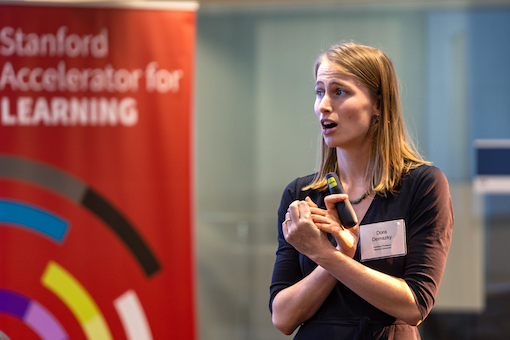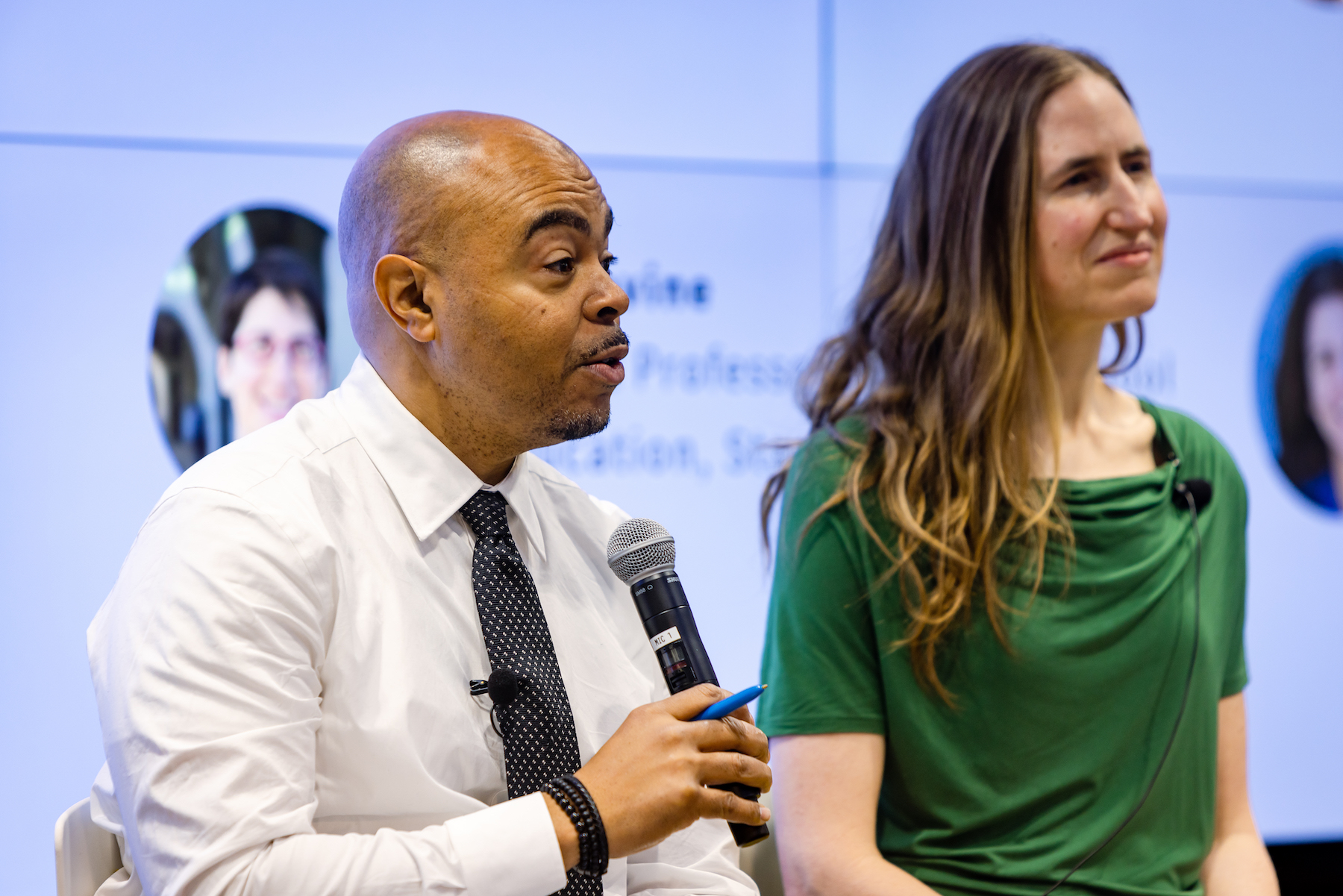AI Will Transform Teaching and Learning. Let’s Get it Right.

At the recent AI+Education Summit, Stanford researchers, students, and industry leaders discussed both the potential of AI to transform education for the better and the risks at play.
When the Stanford Accelerator for Learning and the Stanford Institute for Human-Centered AI began planning the inaugural AI+Education Summit last year, the public furor around AI had not reached its current level. This was the time before ChatGPT. Even so, intensive research was already underway across Stanford University to understand the vast potential of AI, including generative AI, to transform education as we know it.
By the time the summit was held on Feb. 15, ChatGPT had reached more than 100 million unique users, and 30% of all college students had used it for assignments, making it one of the fastest-ever applications ever adopted overall – and certainly in education settings. Within the education world, teachers and school districts have been wrestling with how to respond to this emerging technology.
The AI+Education Summit explored a central question: How can AI like this and other applications be best used to advance human learning?
“Technology offers the prospect of universal access to increase fundamentally new ways of teaching,” said Graduate School of Education Dean Daniel Schwartz in his opening remarks. “I want to emphasize that a lot of AI is also going to automate really bad ways of teaching. So [we need to] think about it as a way of creating new types of teaching.”
Researchers across Stanford – from education, technology, psychology, business, law, and political science – joined industry leaders like Sal Khan, founder and CEO of Khan Academy, in sharing cutting-edge research and brainstorming ways to unlock the potential of AI in education in an ethical, equitable, and safe manner.
Participants also spent a major portion of the day engaged in small discussion groups in which faculty, students, researchers, staff, and other guests shared their ideas about AI in education. Discussion topics included natural language processing applied to education; developing students’ AI literacy; assisting students with learning differences; informal learning outside of school; fostering creativity; equity and closing achievement gaps; workforce development; and avoiding potential misuses of AI with students and teachers.
Several themes emerged over the course of the day on AI’s potential, as well as its significant risks.
First, a look at AI’s potential:
1. Enhancing personalized support for teachers at scale
Great teachers remain the cornerstone of effective learning. Yet teachers receive limited actionable feedback to improve their practice. AI presents an opportunity to support teachers as they refine their craft at scale through applications such as:
Simulating students: AI language models can serve as practice students for new teachers. Percy Liang, director of the Stanford HAI Center for Research on Foundation Models, said that they are increasingly effective and are now capable of demonstrating confusion and asking adaptive follow-up questions.
Real-time feedback and suggestions: Dora Demszky, assistant professor of education data science, highlighted the ability for AI to provide real-time feedback and suggestions to teachers (e.g., questions to ask the class), creating a bank of live advice based on expert pedagogy.
Post-teaching feedback: Demszky added that AI can produce post-lesson reports that summarize the classroom dynamics. Potential metrics include student speaking time or identification of the questions that triggered the most engagement. Research finds that when students talk more, learning is improved.
Refreshing expertise: Sal Khan, founder of online learning environment Khan Academy, suggested that AI could help teachers stay up-to-date with the latest advancements in their field. For example, a biology teacher would have AI update them on the latest breakthroughs in cancer research, or leverage AI to update their curriculum.
2. Changing what is important for learners
Stanford political science Professor Rob Reich proposed a compelling question: Is generative AI comparable to the calculator in the classroom, or will it be a more detrimental tool? Today, the calculator is ubiquitous in middle and high schools, enabling students to quickly solve complex computations, graph equations, and solve problems. However, it has not resulted in the removal of basic mathematical computation from the curriculum: Students still know how to do long division and calculate exponents without technological assistance. On the other hand, Reich noted, writing is a way of learning how to think. Could outsourcing much of that work to AI harm students’ critical thinking development?
Liang suggested that students must learn about how the world works from first principles – this could be basic addition or sentence structure. However, they no longer need to be fully proficient – in other words, doing all computation by hand or writing all essays without AI support.
In fact, by no longer requiring mastery of proficiency, Demszky argued that AI may actually raise the bar. The models won’t be doing the thinking for the students; rather, students will now have to edit and curate, forcing them to engage deeper than they have previously. In Khan’s view, this allows learners to become architects who are able to pursue something more creative and ambitious.

And Noah Goodman, associate professor of psychology and of computer science, questioned the analogy, saying this tool may be more like the printing press, which led to democratization of knowledge and did not eliminate the need for human writing skills.
3. Enabling learning without fear of judgment
Ran Liu, chief AI scientist at Amira Learning, said that AI has the potential to support learners’ self-confidence. Teachers commonly encourage class participation by insisting that there is no such thing as a stupid question. However, for most students, fear of judgment from their peers holds them back from fully engaging in many contexts. As Liu explained, children who believe themselves to be behind are the least likely to engage in these settings.
Interfaces that leverage AI can offer constructive feedback that does not carry the same stakes or cause the same self-consciousness as a human’s response. Learners are therefore more willing to engage, take risks, and be vulnerable.
One area in which this can be extremely valuable is soft skills. Emma Brunskill, associate professor of computer science, noted that there are an enormous number of soft skills that are really hard to teach effectively, like communication, critical thinking, and problem-solving. With AI, a real-time agent can provide support and feedback, and learners are able to try different tactics as they seek to improve.
4. Improving learning and assessment quality
Bryan Brown, professor of education, said that “what we know about learning is not reflected in how we teach.” For example, teachers know that learning happens through powerful classroom discussions. However, only one student can speak up at a time. AI has the potential to support a single teacher who is trying to generate 35 unique conversations with each student.

This also applies to the workforce. During a roundtable discussion facilitated by Stanford Digital Economy Lab Director Erik Brynjolfsson and Candace Thille, associate professor of education and faculty lead on adult learning at the Stanford Accelerator for Learning, attendees noted that the inability to judge a learner’s skill profile is a leading industry challenge. AI has the potential to quickly determine a learner’s skills, recommend solutions to fill the gaps, and match them with roles that actually require those skills.
Of course, AI is never a panacea. Now a look at AI’s significant risks:
1. Model output does not reflect true cultural diversity
At present, ChatGPT and AI more broadly generates text in language that fails to reflect the diversity of students served by the education system or capture the authentic voice of diverse populations. When the bot was asked to speak in the cadence of the author of The Hate U Give, which features an African American protagonist, ChatGPT simply added “yo” in front of random sentences. As Sarah Levine, assistant professor of education, explained, this overwhelming gap fails to foster an equitable environment of connection and safety for some of America’s most underserved learners.
2. Models do not optimize for student learning
While ChatGPT spits out answers to queries, these responses are not designed to optimize for student learning. As Liang noted, the models are trained to deliver answers as fast as possible, but that is often in conflict with what would be pedagogically sound, whether that’s a more in-depth explanation of key concepts or a framing that is more likely to spark curiosity to learn more.
3. Incorrect responses come in pretty packages
Goodman demonstrated that AI can produce coherent text that is completely erroneous. His lab trained a virtual tutor that was tasked with solving and explaining algebra equations in a chatbot format. The chatbot would produce perfect sentences that exhibited top-quality teaching techniques, such as positive reinforcement, but fail to get to the right mathematical answer.
4. Advances exacerbate a motivation crisis
Chris Piech, assistant professor of computer science, told a story about a student who recently came into his office crying. The student was concerned about the rapid progress of ChatGPT and how this would deter future job prospects after many years of learning how to code. Piech connected the incident to a broader existential motivation crisis, where many students may no longer know what they should be focusing on or don’t see the value of their hard-earned skills.
The full impact of AI in education remains unclear at this juncture, but as all speakers agreed, things are changing, and now is the time to get it right.
Stanford HAI’s mission is to advance AI research, education, policy and practice to improve the human condition. Learn more
Watch the full AI+Education Summit


